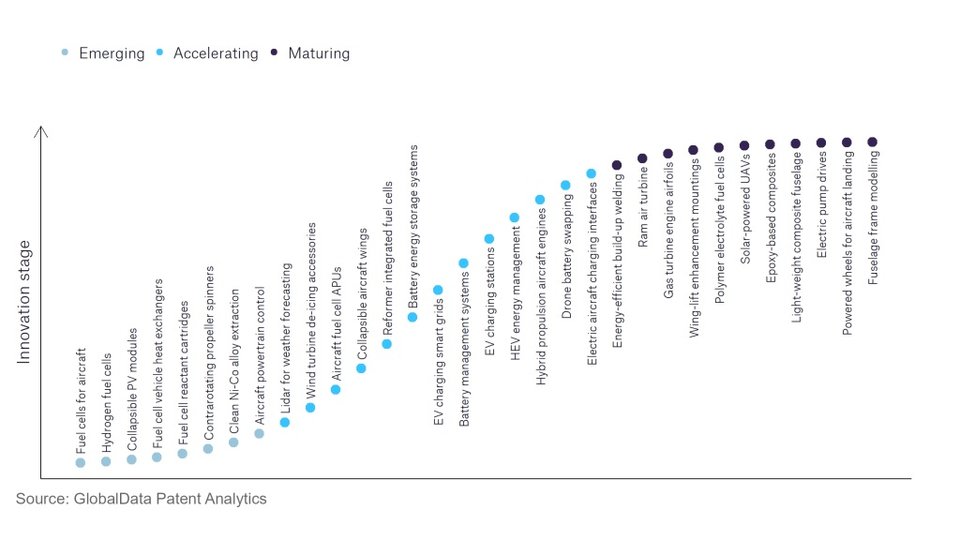SUSTAINABILITY
Environmental sustainability: leading companies in polymer electrolyte fuel cells
Powered by
Defence companies are continuing to innovate and develop new technologies in key areas such as sustainability, which will bring multiple benefits to operators, according to GlobalData analysis.
Activity in the aerospace and defence industry continues to be driven by the need to lower operational costs, consumer trends, and electrification, as well as growing importance of technologies such as hydrogen and electric aircraft and advanced materials. In the last three years alone, there have been over 174,000 patents filed and granted in the sector, according to GlobalData’s report on Environment Sustainability in Aerospace, Defence & Security: Polymer electrolyte fuel cells.
However, not all innovations are equal and nor do they follow a constant upward trend. Instead, their evolution takes the form of an S-shaped curve that reflects their typical lifecycle from early emergence to accelerating adoption, before finally stabilising and reaching maturity.
Identifying where a particular innovation is on this journey, especially those that are in the emerging and accelerating stages, is essential for understanding their current level of adoption and the likely future trajectory and impact they will have.
180+ innovations will shape the aerospace and defence industry
According to GlobalData’s Technology Foresights, which plots the S-curve for the aerospace and defence industry using innovation intensity models built on over 262,000 patents, there are 180+ innovation areas that will shape the future of the industry.
Within the emerging innovation stage, hydrogen fuel cells, contrarotating propeller spinners, and fuel cells for aircrafts are disruptive technologies that are in the early stages of application and should be tracked closely. EV charging stations, hybrid propulsion aircraft engines, and electric aircraft charging interfaces are some of the accelerating innovation areas, where adoption has been steadily increasing. Among maturing innovation areas are fuselage frame modelling and powered wheels for aircraft landing, which are now well established in the industry.
Innovation S-curve for environmental sustainability in the aerospace and defence industry

Patent volumes related to polymer electrolyte fuel cells
Airbus is one of the leading patent filers in polymer electrolyte fuel cells amongst aerospace and defence companies. Airbus is leading the way in the development of hydrogen propulsion in commercial aviation and is targeting to roll out a hydrogen-powered aircraft under its ZEROe programme by 2035.
Polymer electrolyte fuel cells function under the principle of anode oxidation of hydrogen fuel to protons and the reduction of oxygen at the cathode, producing electrical energy and water. This electrical energy can then be used to produce thrust to drive electrical motors. Other key patent filers include Raytheon Technologies and Mitsubishi Heavy Industries.
In terms of application diversity, ThermoChem Recovery International leads the pack, followed by EADS Deutschland and Arkema holding the second and third positions, respectively. Regarding geographic reach, Armines holds the top position, followed by ThyssenKrupp and Naval Group.
Polymer electrolyte fuel cells hold possible applications in aerospace, providing a low emission power source alternative to conventional kerosene. As the only emission from polymer electrolyte fuel cells is water, the technology could reduce greenhouse emissions during flight to essentially zero, although contrails may still have some albedo related warming effects.
Driven by consumer expectation and government regulation, it is increasingly likely that commercial aviation firms will be influenced by climate considerations, going forward.